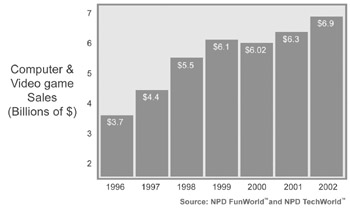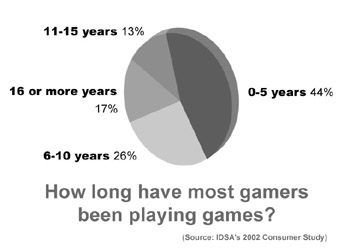Platforms For Distribution
|
| < Day Day Up > |
|
The Size Of The Game Industry
The game industry currently brings in around $36 billion dollars annually worldwide. In the United States alone annual revenues are about $10 billion, which is slightly bigger that the U.S. domestic box office revenues from the film industry. Because of this, many people refer to games as 'bigger than movies' these days. This isn't precisely true-movies make most of their money today on DVD sales, as well as rights for broadcast, cable, and foreign distribution. The $10 billion number for games revenue also includes hardware sales. If we only look at software sales alone, which are a more equivalent comparison to box office revenues, the U.S. game industry makes about $6.9 billion annually. So while games are large and growing, they still have a ways to go before they truly surpass the film industry in terms of domestic revenue.

Figure 15.1: Videogame sales growth
It may not take long before the games industry bridges this gap, however, because the industry has remained strong, even in the face of recession, and has grown steadily over the past decade. Figure 15.1 shows the growth of videogame sales (PC and console) in the U.S. since 1995.
Digital games have become a significant form of entertainment since their introduction in the 1970s. Today, more than 60% of all Americans, or about 145 million people, play games on a regular basis.[1] The split between men and women players is closing as well, with women comprising 38% of PC gamers and 28% of console players. As several generations of players have grown up with digital games, most have continued to play as they grew older: 40% of PC gamers are over the age of 36, and 26% are between 18 and 35. The majority of game players have been playing for more than six years. Figure 15.2 shows that gaming is a phenomenon that people tend to continue once they've begun.
According to Entertainment Software Association President Doug Lowenstein, 'Video games have become a leading form of mass market entertainment as the core user has aged from the teens into adulthood, and millions more casual gamers join the hard core gamers to drive market growth and expansion.'[2] All of these statements point to the fact that digital games are no longer a niche market. They are making the transition from being a pastime to becoming an integral part of the entertainment industry. In many ways, they are redefining our culture and our expectations about media and entertainment. Journalist Bob Schwabach said in a New York Times article, 'The video game industry has been on the threshold of seizing dominance in entertainment for several years. Ultimately, it will. It's inevitable.'
This phenomenon is not limited to the United States. The game industry is growing worldwide. The U.S. may be the single largest market, but countries like Japan, the U.K., Canada, and France are also known for their game industries and high- quality products. The worldwide sales of videogames are nearly $18 billion annually, with another $18 billion in hardware and peripheral sales making the total worldwide game market approximately $36 billion per year.[3]

Figure 15.2: How long have most gamers been playing games?
[1]Peter D. Hart Research, as quoted in 'Essential Facts about the Computer and Game Industry,' Entertainment Software Association.
[2]Entertainment Software Association, 'Essential Facts about the Computer and Game Industry.'
[3]Global Information, Inc., 'Video Games: The Dominant Form of Electronic Entertainment.'
|
| < Day Day Up > |
|
EAN: 2147483647
Pages: 162